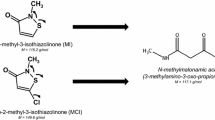Summary
the kinetics of lindane concentration in the serum and the timedependant urinary excretion of two groups, one with healthy subjects and one with scabies-infested subjects, were comparatively analyzed by gas chromatography. Both groups showed similar cumulative excretion curves at completely different lindane concentrations in the serum. Comparison of serum concentration in healthy females (high lindane concentration in serum) and healthy males (low serum concentration) to the urinary excretion showed similar results. There appears to be a serum ‘threshold concentration’, above which it is possible that lindane is no longer primarily excreted by the kidney. Based on these results recommendations are presented, for the practical use of such data in the treatment of scabies.
Similar content being viewed by others
References
Feldmann RJ, Maibach HJ (1970) Absorption of some organic compounds through the skin in man. J Invest Dermatol 54:399–404
Zesch A, Schaefer H, Stüttgen G (1979) The quantitative distribution of percutaneously applied coffeine in the human skin. Arch Dermatol Res 266:277–283
Ippen H, Kölmel K (1977) Perkutane Coffeinvergiftung. Dtsch Med Wochenschr 102:1851
Ginsburg ChM, Lowry W, Reisch JS (1977) Absorption of lindane (gamma-benzene hexachloride) in infants and children. J Pediatr 6:998–1000
Kolmodin-Hedmann B, Werner Y (1975). Svensk Läk-Sällsk Handl 84:80
Lange M, Nitzsche K, Zesch A (1981) Percutaneous absorption of lindane in healthy volunteers and scabies patients. — Depency of penetration kinetics in serum upon frequency of application, time and mode of washing. Arch Dermatol Res 271:387–399
Feldmann RJ, Maibach HI (1974) Percutaneous penetration of some pesticides and herbicides in man. Toxicol Appl Pharmacol 28:126–132
Ulmann E (1972) Lindan-Monographie eines insektiziden Wirkstoffes. K. Schillinger, Freiburg
Burrage RH, Saha JG (1972) Insecticide residues in pheasant after being on wheat seed treated with heptachlor and carbon-14-lindane. Econ Etnomol 65:1013
Grosser V, Knoll W (1973) Chlorierte Kohlenwasserstoffe im Blut des Menschen unter den Bedingungen der Nahrungskarenz. Dtsch Ges Wesen 28:1997–1001
Czeglédi-Jankó G (1969) Rückstände von chlorierten Kohlenwasserstoffen im Blut der Einwohnerschaft von Budapest im Jahre 1967/68 unter besonderer Berücksichtigung von Lindan. 2 Ges Hyg-Grenzgebiete 15:755–761
Trombetti G, Gordini T (1971) Quantitative determination of the γ-isomer of BHC in technical products and formulations. J chromatogr 60:251–252
Kitamura S, Sumino D, Hayakawa K (1970) (cited in reference 8). Jp J Publ Health 17:108–112
Author information
Authors and Affiliations
Rights and permissions
About this article
Cite this article
Zesch, A., Nitzsche, K. & Lange, M. Demonstration of the percutaneous resorption of a lipophilic pesticide and its possible storage in the human body. Arch Dermatol Res 273, 43–49 (1982). https://doi.org/10.1007/BF00509026
Received:
Issue Date:
DOI: https://doi.org/10.1007/BF00509026




